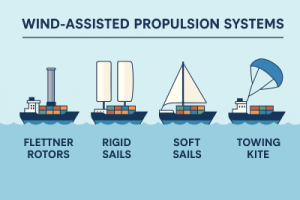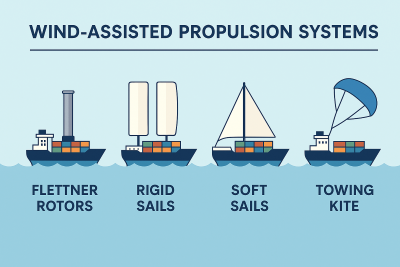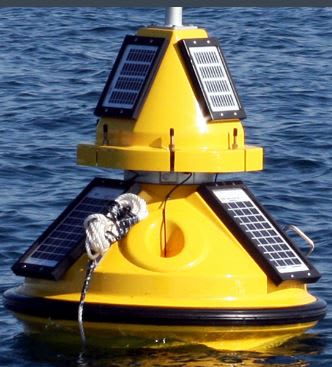Wind-Assisted Propulsion: The Revival of Sails
Introduction
As global industries work to minimize carbon emissions, the maritime field is revisiting an age-old technology known as sails. However, these sails differ from the canvas ones used on historical tall ships. Instead, wind-assisted propulsion (WAP) technologies combine contemporary engineering with the natural force of the wind, providing a practical solution for more eco-friendly shipping. This resurgence represents a hopeful advancement toward sustainable maritime transport.
In this article, we delve into the emergence of wind-assisted propulsion, its advantages, the various technologies involved, and the obstacles that lie ahead. We also evaluate its contribution to reducing carbon footprints in the shipping sector.

What Is Wind-Assisted Propulsion?
Wind-assisted propulsion means utilizing wind energy to partially power commercial vessels, thus lessening dependence on fossil fuels. Rather than completely replacing engines, these systems complement traditional propulsion methods to improve fuel efficiency and lower emissions.
Crucially, wind-assisted propulsion is not just one singular technology. It includes a variety of systems, such as:
- Rotors (Flettner Rotors)
- Rigid Sails
- Soft Sails
- Kites
- Towing Kites
- Wing Sails
Each method captures wind in its unique way, yet they all share the common objective of enhancing the sustainability of ships.
The Rise of Wind-Assisted Propulsion in Contemporary Shipping
While wind was the primary force behind global maritime trade for centuries, it diminished with the advent of steam and diesel engines. Currently, with increasing environmental regulations and the urgency to decarbonize, wind is experiencing a revival—but in a more intelligent and efficient manner.
The International Maritime Organization (IMO) aims to decrease greenhouse gas emissions from international shipping by at least 50% by 2050 compared to levels in 2008. This target, coupled with rising fuel costs and the need for regulatory compliance, is motivating shipowners to investigate wind-assisted technologies.
Furthermore, recent progress in automation, materials, and real-time weather routing has made wind propulsion more feasible than ever. Several commercial vessels have already successfully implemented retrofits and new builds featuring wind-assisted systems.
Types of Wind-Assisted Propulsion Technologies
-
Flettner Rotors
Flettner rotors are tall, cylindrical devices that rotate using motors. As they spin, they create a pressure difference due to the Magnus effect, producing lift and driving the ship forwar
- Advantages: High thrust efficiency; suitable for retrofits.
- Drawbacks: Requires energy to turn; effectiveness relies on wind direction.
-
Rigid Sails and Wing Sails
These fixed structures resemble aircraft wings and are often controlled by computers to align with wind direction.
- Advantages: Excellent aerodynamic efficiency; minimal energy requirement.
- Drawbacks: May interfere with cargo operations and need structural support.
-
Soft Sails
Modern adaptations of traditional fabric sails, these systems can be automated and retracted when not in action.
- Advantages: Lightweight and flexible; lower cost.
- Drawbacks: Less effective in strong wind conditions.
-
Towing Kites
These large kites are deployed in front of the ship and can operate at heights with stronger, more consistent winds.
- Advantages: Minimal disruption to deck operations; significant thrust in favorable conditions.
- Drawbacks: Complex deployment mechanisms; reliant on weather conditions.
Advantages of Wind-Assisted Propulsion
-
Fuel Efficiency
One of the most immediate advantages is the reduction in fuel usage. Depending on the technology and wind conditions, wind-assisted systems can decrease fuel consumption by 5–30%, significantly reducing operational costs.
-
Emission Decrease
By using less fuel, vessels release lower amounts of CO₂, NOₓ, and SOₓ, assisting operators in adhering to regulations such as the IMO’s EEXI (Energy Efficiency Existing Ships Index (EEXI) and CII (Carbon Intensity Indicator) ratings.
-
Prolonged Engine Durability
Reduced pressure on engines leads to less wear and tear, potentially extending their longevity and lowering maintenance expenses.
-
Energy Independence
Wind serves as a free and renewable energy source. As fuel markets fluctuate, wind-assisted propulsion acts as a buffer against instability.
Challenges Confronting Wind-Assisted Propulsion
-
Integration Difficulties
Retrofitting a ship with wind systems can be technically demanding. Aspects such as deck space, vessel stability, and cargo handling interference must be thoroughly considered.
-
High Initial Investment
The upfront costs for installation can be significant. While operating expenses may be lower, the initial capital might dissuade some shipowners.
-
Operational Constraints
Wind conditions are not always ideal. Moreover, sailing routes may need alterations to optimize wind utilization, which could impact voyage planning.
-
Crew Training and Maintenance
New systems frequently necessitate specialized training and maintenance procedures. Ensuring crew proficiency and technical support is essential for sustained success.
Case Studies: Practical Implementations
- MV Afros: A bulk carrier outfitted with four Flettner rotors, achieving fuel savings exceeding 12%.
- Ville de Bordeaux: Employs an Airseas kite system for transatlantic journeys, reducing fuel consumption by up to 20%.
- Pyxis Ocean: One of the first vessels to trial BAR Technologies’ WindWings, demonstrating large wing sails in commercial use.
These examples illustrate that the technology is not merely theoretical but it is already demonstrating effectiveness at sea.
The Horizon of Wind-Assisted Propulsion
As environmental regulations become stricter and technology progresses, wind-assisted propulsion is set for wider acceptance. Several key trends are influencing its future:
- Hybrid Systems: Merging wind with other alternative fuels such as ammonia or methanol could further minimize emissions.
- Digital Integration: Weather routing software and AI optimization will enhance wind capture and route efficiency.
- Policy Backing: Subsidies, green shipping corridors, and carbon pricing could hasten adoption.
Additionally, collaborative industry efforts like the International Windship Association (IWSA) are promoting awareness, standardization, and policy advocacy.
Conclusion
Wind-assisted propulsion signifies more than just a nostalgic reference to maritime history but it’s a practical and future-oriented solution to contemporary environmental challenges. By creatively harnessing wind, the shipping industry can lessen its carbon footprint while enhancing operational efficiency. While challenges persist, the momentum is unmistakable. With ongoing investment, collaboration, and regulatory support, the revival of sails may help navigate a cleaner path for global trade.



